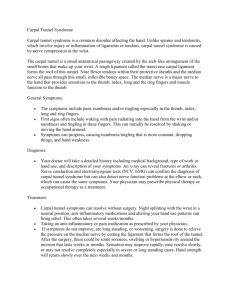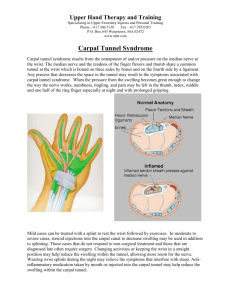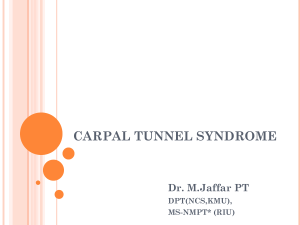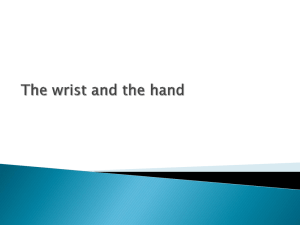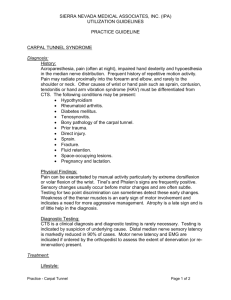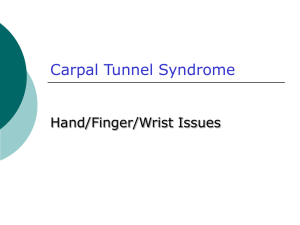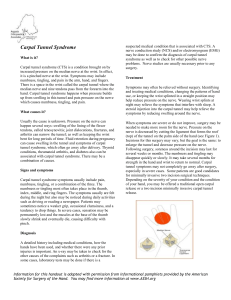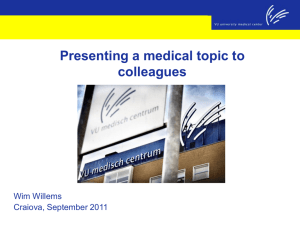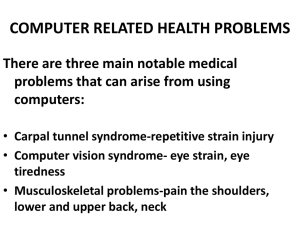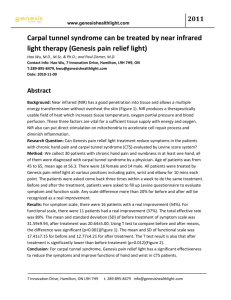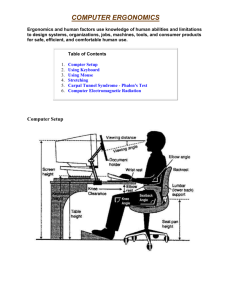Carpal Tunnel Syndrome
advertisement
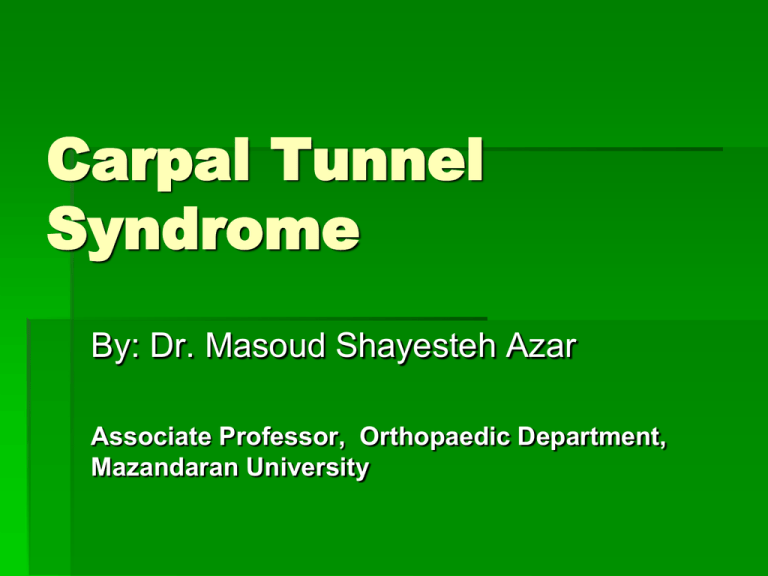
Carpal Tunnel Syndrome By: Dr. Masoud Shayesteh Azar Associate Professor, Orthopaedic Department, Mazandaran University Definition Compression neuropathy of the median nerve in wrist area ( tardy median nerve palsy) Described in 1854 by Sir James Paget anatomy The median nerve travels from the forearm into your hand through a “tunnel” in your wrist. Anatomy hook of the hamate triquetrum and pisiform medially scaphoid trapezium and fibroosseous F.c.r. sheath laterally. Carpal tunnel syndrome Pressure on the median nerve can result in; sensations of numbness, tingling, pain and clumsiness of the hand.( typical median N. distribution in the radial three and one – half digits). The combination of these symptoms is called carpal tunnel syndrome Carpal tunnel syndrome Most often 30 -60 years old Five times more common in women Older, overweight, and physically inactive people Carpal tunnel syndrome Carpal tunnel syndrome Etiology 1-primery or Idiopathic 2- secondary A: Local etiology I: Anatomical malformation II: Tumors III: Infections IV: Bone prominence B: Systemic etiology obesity, diabetes mellitus, thyroid dysfunction, R.A Computer Related Health Hazards Research Topics Repetitive Strain Injuries Carpal Tunnel Syndrome Eye Strains and Computer Vision Syndrome Internet Addiction Stress and Depression Radiation Clinical finding History often is more important than the physical examination in making the diagnosis of CTS Numbness and tingling hands fall asleep or things slip from the fingers without the person's noticing (loss of grip, dropping things), as well as numbness and tingling Symptoms are usually intermittent and are associated with certain activities (i.e., driving, reading the newspaper, crocheting, painting) Nocturnal symptoms that wake the individual are more specific of CTS, especially if the patient relieves symptoms by shaking the hand/wrist Clinical finding If pressure continues- thenar muscles can weaken and atrophy diagnosis History Clinical examination I: Tinel's nerve percussion test II: Phalen's wrist flexion test III: Tourniquet test IV: Carpal compression test V: Tethered median nerve stress test Para clinical examination diagnosis Reverse Phalen Test Electrodes are placed on the forearm and a mild electrical current is passed through the arm. diagnosis Electromyography 90% sensitive and 60% specific Measurement of how fast & how well the median nerve responds indicates if there is damage to the nerve. treatment 1- Non surgical treatment 2- Surgical treatment Endoscopic release 1-age over 50 2-duration longer than 10 months 3-constant paresthesia 4- stenosing flexor tenosynovitis 5-positive phalen test less than 30 seconds treatment Steroids by local injection Splints, especially if worn full time NSAIDs, diuretics, yoga, laser & ultrasound Non surgical treatment Local steroid injection for moderately severe idiopathic carpal tunnel syndrome BMC Musculoskelet Disord. 2010 Published online 2010 April Department of Orthopedics, Hässleholm and Kristianstad Hospitals, SE-28125 Hässleholm, Sweden Non surgical treatment randomized double-blind placebo-controlled trial A total of 120 patients will be randomized to injection of 80 mg Methylprednisolone, 40 mg Methylprednisolone, or normal saline, each also containing 10 mg Lidocaine. Evaluation at baseline and at 5, 10, 24 and 52 weeks after injection includes validated Non surgical treatment Non surgical treatment Surgical treatment Surgical Decompression Open or endoscopic (similar success) Only means of definitive cure (American Academy of Neurologists) Up to 86% improvement in pain Complication 1-2% (higher in endoscopic) Wilson JK, Sevier TL. A review of treatment for carpal tunnel syndrome. Clinical Rehabilitation. 2003; 25:3:113-119. Surgical complication 1- Infection 2- Nerve injury 3- Reflex Sympathetic Dystrophy 4- Painful scar 5- Bowstringing 6- Muscle weakness 7- Skin necrosis Recurrence In 1000 case 20% recurrence reported Causes: 1- Adhesion 2- Anatomical abnormality Study -1 89 patient operated in Sari Emam hospital between 1386 -1388 All of them open surgery 15 male (17%) 74 female (83%) Study -2 Rt. Hand 54 case (60%) Lt. hand 36 case (40%) Total age average 46/44 +/-11/45 Male age average 48/26 +/-14/19 Female age average 46/08 +/-10/89 Study -3 Age minimum 22y.old Age maximum 77y.old Mode 53 y. old Complication after 2 years follow up 1- Recurrence 11 case (12.3%) 2- Pain full scar 5 case (5.6%) 3-sympathetic dystrophy 4 case (4.4%) 4-palmar coetaneous N. injury 2 case (2.2%) 5- thenar branch N. injury 1 case (1.1%) Thank you for your attention
